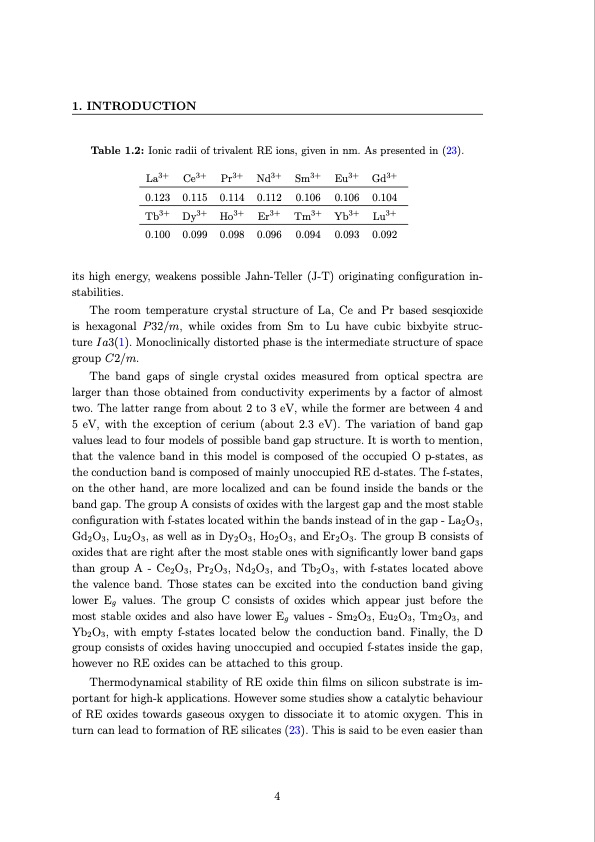
PDF Publication Title:
Text from PDF Page: 025
1. INTRODUCTION Table 1.2: Ionic radii of trivalent RE ions, given in nm. As presented in (23). La3+ Ce3+ Pr3+ Nd3+ Sm3+ Eu3+ Gd3+ 0.123 0.115 0.114 0.112 0.106 0.106 0.104 Tb3+ Dy3+ Ho3+ Er3+ Tm3+ Yb3+ Lu3+ 0.100 0.099 0.098 0.096 0.094 0.093 0.092 its high energy, weakens possible Jahn-Teller (J-T) originating configuration in- stabilities. The room temperature crystal structure of La, Ce and Pr based sesqioxide is hexagonal P32/m, while oxides from Sm to Lu have cubic bixbyite struc- ture Ia3(1). Monoclinically distorted phase is the intermediate structure of space group C2/m. The band gaps of single crystal oxides measured from optical spectra are larger than those obtained from conductivity experiments by a factor of almost two. The latter range from about 2 to 3 eV, while the former are between 4 and 5 eV, with the exception of cerium (about 2.3 eV). The variation of band gap values lead to four models of possible band gap structure. It is worth to mention, that the valence band in this model is composed of the occupied O p-states, as the conduction band is composed of mainly unoccupied RE d-states. The f-states, on the other hand, are more localized and can be found inside the bands or the band gap. The group A consists of oxides with the largest gap and the most stable configuration with f-states located within the bands instead of in the gap - La2O3, Gd2O3, Lu2O3, as well as in Dy2O3, Ho2O3, and Er2O3. The group B consists of oxides that are right after the most stable ones with significantly lower band gaps than group A - Ce2O3, Pr2O3, Nd2O3, and Tb2O3, with f-states located above the valence band. Those states can be excited into the conduction band giving lower Eg values. The group C consists of oxides which appear just before the most stable oxides and also have lower Eg values - Sm2O3, Eu2O3, Tm2O3, and Yb2O3, with empty f-states located below the conduction band. Finally, the D group consists of oxides having unoccupied and occupied f-states inside the gap, however no RE oxides can be attached to this group. Thermodynamical stability of RE oxide thin films on silicon substrate is im- portant for high-k applications. However some studies show a catalytic behaviour of RE oxides towards gaseous oxygen to dissociate it to atomic oxygen. This in turn can lead to formation of RE silicates (23). This is said to be even easier than 4PDF Image | Investigation of metal-insulator transition in magnetron sputtered samarium nickelate thin films

PDF Search Title:
Investigation of metal-insulator transition in magnetron sputtered samarium nickelate thin filmsOriginal File Name Searched:
Bilewska_Investigation_of_metal_insulator_transition_in_magnetron_sputtered_samarium.pdfDIY PDF Search: Google It | Yahoo | Bing
Sulfur Deposition on Carbon Nanofibers using Supercritical CO2 Sulfur Deposition on Carbon Nanofibers using Supercritical CO2. Gamma sulfur also known as mother of pearl sulfur and nacreous sulfur... More Info
CO2 Organic Rankine Cycle Experimenter Platform The supercritical CO2 phase change system is both a heat pump and organic rankine cycle which can be used for those purposes and as a supercritical extractor for advanced subcritical and supercritical extraction technology. Uses include producing nanoparticles, precious metal CO2 extraction, lithium battery recycling, and other applications... More Info
| CONTACT TEL: 608-238-6001 Email: greg@infinityturbine.com | RSS | AMP |